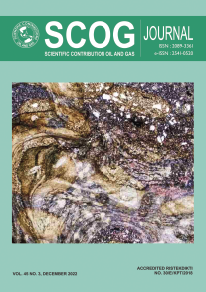Oil to Source Rock Correlation of Besuki Area and its Role in Petroleum System of Banyumas Basin
DOI:
https://doi.org/10.29017/SCOG.45.3.1256Keywords:
Source Rock, Oil Seep, Banyumas Basin, Correlation.Abstract
Banyumas Basin is a basin that has signs of the presence of hydrocarbons, including oil and gas
seep on the surface, which indicates active petroleum systems in the subsurface. A lot of oil and gas seeps were
found in Banyumas Basin, including oil seeps in Cipari and Besuki, while gas seeps were found in Mount Wetan,
Karanglewas, and also Cipari. Exploration drilling wells have also been carried out, such as the Jati-1 Well, Karang
Nangka-1, Karang Gedang-1, Tjipari-1, and Mount Wetan-1, but there still has been no significant evidence
of this basin producing hydrocarbons. The TOC value of the outcrop samples taken in Cipari and Besuki have bad
values, while the crude oil has reflected a severe biodegradation process. Both oil seep samples and one extract
bitumen contained high bicadinane (R (resin) annotation) and oleanane indicating both oils and extract to have an
input to Tertiary-sourced oils throughout Southeast Asia. Both oil seep samples do not exhibit similarity with the
extract source rock. Based on this negative correlation there may be another source rocks in Banyumas Basin, derived
from rocks that are not only from Pemali Formation. The existence of this research is expected to be able to
add geological data, especially hydrocarbon geochemical data in Banyumas Basin, so that it can provide evidence
of the prospect and calculation of reserves contained in this basin, and an understanding of the source rock it self.
References
Anil. 2021. Analisis Biomarker dari Sampel
Rembesan Minyak Dan Sampel Batuan Pada
Sub-Cekungan Banyumas. Bachelor thesis of
Geological Engineering Universitas Trisakti
(unpublished).
Cox, H.C., de Leeuw, J.W., Schenck, P.A., van
Koningsveld, H., Jansen, J.C., van de Graaf,
B., van Geerestein, B., Kanters, J.A., Kruk,
C., and Jans, A.W.R., 1986. Bicadinane, a C30
pentacyclic isoprenoid hydrocarbon found in
crude oil. Nature 319, 316-318.
Grantham, P.L., Posthuma, J., and Baak A., 1983.
Triterpanes in a number of Far-Eastern crude oils.
Dalam Bjoray, M. (eds). Advances in organic
geochemistry 1981. Wiley, Chichester, 675-683.
Huang W.Y and Meinschein W.G., 1979. Sterols
as Ecological Indicators. Geochimica and Cosmochimica
Acta 43 739-45.
Kabul Y.A., Aswan, and Purwasatriya E.B., 2012.
Studi formasi Pemali daerah Besuki dan sekitarnya,
Kecamatan Lumbir, Kabupaten Banyumas,
Jawa Tengah. Jurnal JTM. 19 (4): 181-190.
LEMIGAS, 2005. Summary on Petroleum Geology
of Indonesia’s Sedimentary Basins, Prepared for
Patra Nusa Data, Jakarta.
Lunt, P., Burgon, G., and Baky, A. A., 2008. The
Pemali Formation of Central Java and Equivalents:
Indicators of Sedimentation on an Active
Plate Margin, Journal of Asian Earth Sciences.
Moldowan, J.M., Dahl, J., and Huizinga, B.J.,
The molecular fossil record of oleanane and
its relation to angiosperms. Science 265, 768 -771.
Noeradi, D., Subroto E.A., Wahono H.E., Hermanto
E., and Zaim Y., 2006, Basin Evolution
and Hydrocarbon Potential of Majalengka-Bumiayu
Transpression Basin, Java Island, Indonesia:
AAPG 2006 International Conference and Exhibition,
Perth, Australia, 32p.
Peters, K.E., Walters, C.C., and Moldowan, J.M.,
The Biomarker Guide, Vol. I & II. Cambridge
University Press, Cambridge.
Peters, K.E. and Cassa, M.R., 1994. Applied
Source Rock Geochemistry. The Petroleum
System from Source to Trap. The American Association
of Petroleum Geologists Memoir, 60.
Purwasatriya E.B. and Waluyo G., 2012. Studi
potensi minyak dangkal dengan pendekatan
metode statistik berdasar data geologi permukaan
di Cekungan Banyumas. Jurnal Dinamika
Rekayasa. 8 (2): 48-55.
Purwasatriya E.B., Surjono S.S., Amijaya D.H.,
Saputra F.E., and Hendaryono, Said S., 2018,
Tectono-stratigraphy of Banyumas Basin and Its
correlation to Petroleum Potential. Proceedings
South East Asia Technology University Conference
(SEATUC). Yogyakarta, 58.
Purwasatriya, E. B., Surjono, S. S., and Amijaya,
D, H., 2019. Sejarah Geologi Pembentukan
Cekungan Banyumas Serta Implikasinya Terhadap
Sistem Minyak dan Gas Bumi. Jurnal
Dinamika Rekayasa. 15(1): 23-3.
Subroto, E., Noeradi, D., Priyono, A., Wahono,
A.E., Hermanto, E., Praptisih, and Santoso, K.,
, The Paleogene Basin Within the Kendeng
Zone, Central Java Island, and Implication to Hydrocarbon
Prospectivity: Proceedings Indonesian
Petroleum Association, 31st annual convention &
exhibition, Jakarta, 14p.
Subroto, E., Ibrahim, A.M.T., Hermanto, E., and
Noeradi, D., 2008, Contribution of Paleogene and
Neogene sediments to the Petroleum System in
the Banyumas Sub-Basin, Southern Central Java:
AAPG International Conference and Exhibition,
Capetown, 6p.
Sutadiwiria, Y., Hamdani, A.H., Sendjaja, Y.A.,
Haryanto, I., and Yeftamikha, 2018. The Biomarker
Composition of Some Oil Seeps from
West Sulawesi, Indonesia. Indonesian Journal
on Geoscience, 5, No. 3, 214-215.
Sutadiwiria, Y., Yeftamikha, Hamdani, A.H.,
Sendjaja, Y.A., Haryanto, I., and Sunardi, E.,
Origin of Oil Seeps in West Sulawesi Onshore,
Indonesia: Geochemical Constraints and
Paleogeographic Reconstruction of the Source
Facies. Journal of Geological Sciences and Applied
Geology, I (1), Universitas Padjadjaran,
Faculty of Geological Engineering, Bandung,
Indonesia, 10-15.
Wenger, L.M. and Isaksen, G.H., 2002. Control
of hydrocarbon seepage intensity on level of
biodegradation in sea bottom sediments. Organic
Geochemistry 33, 1277-1292.
Downloads
Published
Issue
Section
License
Copyright (c) 2022 © Copyright by Authors. Published by LEMIGAS

This work is licensed under a Creative Commons Attribution 4.0 International License.
Authors are free to Share — copy and redistribute the material in any medium or format for any purpose, even commercially Adapt — remix, transform, and build upon the material for any purpose, even commercially.
The licensor cannot revoke these freedoms as long as you follow the license terms, under the following terms Attribution — You must give appropriate credit , provide a link to the license, and indicate if changes were made . You may do so in any reasonable manner, but not in any way that suggests the licensor endorses you or your use.
No additional restrictions — You may not apply legal terms or technological measures that legally restrict others from doing anything the license permits.














